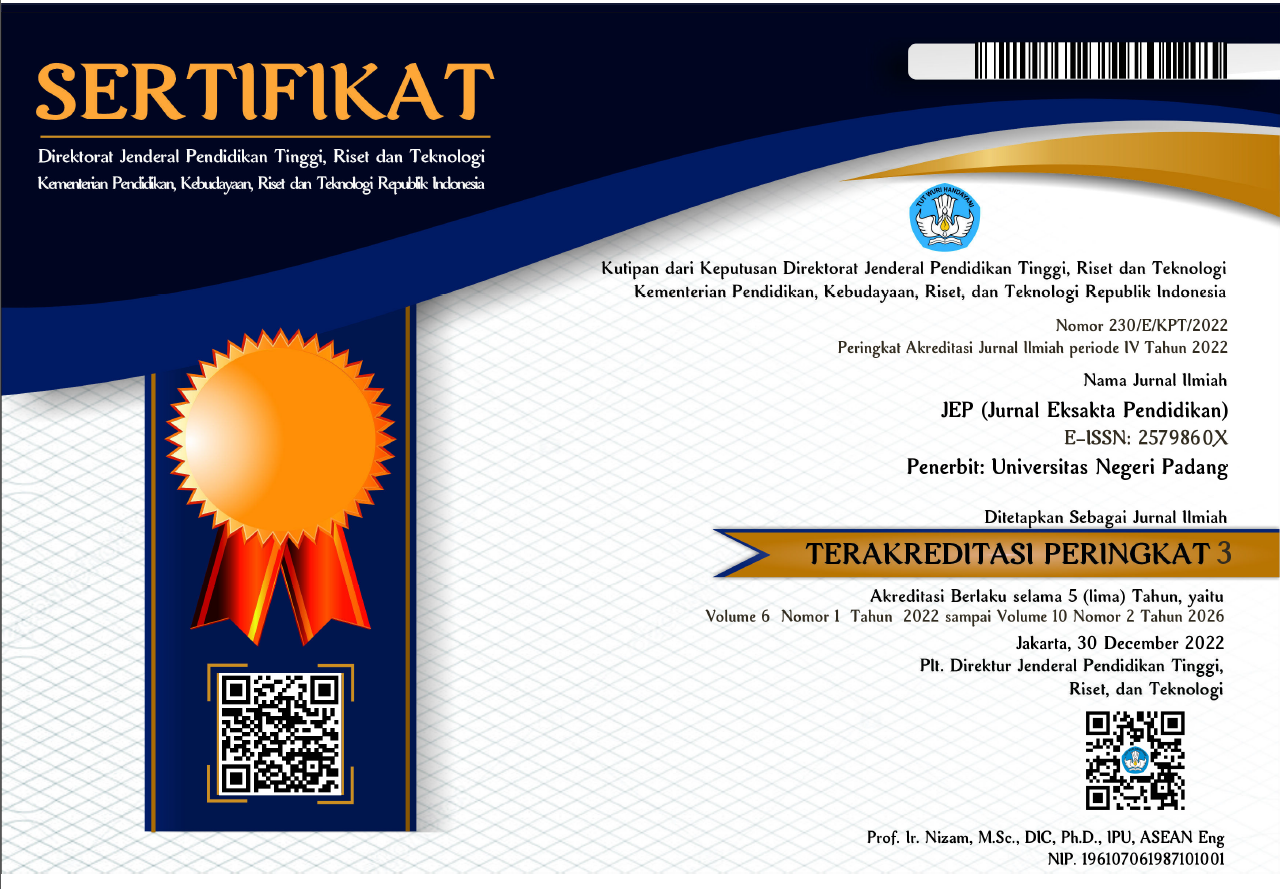Analisis Sajian Buku Ajar Fisika SMA Kelas X Semester 1 Terkait Komponen Science, Technology, Engineering, Mathematics (STEM)
Abstract
An important problem in the 21st century is the integration of information and communication technology in learning. Because teachers and students must be prepared to keep abreast of increasingly sophisticated times. STEM is a learning that integrates science (science), technology (technology), engineering (engineering), and mathematics (mathematics). STEM provides learning through the process of solving problems in everyday life in order to enhance students' creative abilities. STEM learning aims to improve the ability of students to compete with the surrounding environment and globally, both in science and able to innovate technological products. Currently there are many textbooks in circulation with various publishers. For this reason, it is necessary to find out whether the outstanding textbooks have been able to facilitate the implementation of the STEM approach in learning. The solution to this problem is to analyze the extent to which the textbook meets the STEM component. This type of research is a descriptive research with a qualitative approach. The population of data in this research were all physics textbooks for class X semester 1 high school. The samples in this research were five books used in learning physics in class X semester 1 high school. The data in this research were taken using a research instrument which had 4 components which were elaborated into 19 assessment items and data collection techniques used are through observation. The results of this research indicate that the average suitability obtained for each book that is in textbook 1 has a value of 88 with a category in accordance with the STEM component. In textbook 2 has a value of 85 with a category in accordance with the STEM component. In textbook 3 with a value of 72 with categories according to the STEM component. Textbook 4 with a value of 77 with categories according to the STEM component. Finally in textbook 5 with a value of 85 with a category very much in accordance with the STEM component
Downloads
References
Asrizal, & Dewi, W. S. (2018). Development Assistance of Integrated Science Instructional Material by Integrating Real World Context and Scientific Literacy on Science Teachers. Pelita Eksakta, 1(2), 113-120.
Asrizal, Amran, Ananda, & Festiyed. (2018). Effectiveness of Adaptive Contextual Learning Model of Integrated Science by Integrating Digital Age Literacy on Grade VIII Students. IOP Conf. Series: Materials Science and Engineering (pp. 1-9). Padang: Universitas Negeri Padang.
Beers, S. Z. (2011). 21st Century Skills: Preparing Students for THEIR Future.
Budiharti, R., & Devi, N. U. (2016). Efektivitas Model Pembelajaran Kooperatif Tipe The Power Of Two dalam Pembelajaran Fisika. Jurnal Materi dan Pembelajaran Fisika (JMPF), 6(1), 7-13.
Bybee, R. W. (2013, January 7). What is STEM Education. Retrieved from www. sciencemag.org.
Festiyed. (2018). Implementasi Model Pembe lajaran Trait Treatment Interaction (TTI) Menggunakan Multimedia Swish max 4.0. Natural Science Journal, 4(2), 636-650.
Festiyed, & Murtiani. (2013). Meningkatkan Capaian Pembelajaran Mata Kuliah Komputer dalam Pembelajaran Fisika Melalui Implementasi Model Learning Cycle 5E (engagement, Exploration, Explanation, Elaboration, Evaluation). EKSAKTA, 2(1), 1-7.
Herber, Daniel, Deshmukh, A., Mitchell, M., & Allison, J. (2016). Project-Based Curriculum for Teaching Analytical Design to Freshman Engineering Students via Reconfigurable Trebuchets. Education Sciences, 6(1), 7.
Kennedy, T., & Odell, M. (2014). Engaging Students In STEM Education. Science Education International, 25(3), 258.
Masril, Hidayati, & Darvina, Y. (2018). The Development of Virtual Laboratory Using ICT for Physics in Senior High School. IOP Conference Series: Materials Science and Engineering (pp. 1-8). Padang: Universitas Negeri Padang.
Mayo, M. J. (2009). Video Games; A Route to Large-Scale STEM Education. Science, 323, pp. 79-82.
Pangesti, K. I., Yulianti, D., & Sugianto. (2017). Bahan Ajar Berbasis STEM (Science, Technology, Engineering, and Mathematics) untuk Meningkatkan Penguasa an Konsep Siswa SMA. Unnes Physics Education Journal, 6(3), 53-58.
Permanasari, A. (2016). STEM Education: Inovasi dalam Pembelajaran Sains. Prosiding Seminar Nasional Pendidikan Sains (SNPS) (pp. 24-34). Surakarta: Seminar Nasional Pendidikan Sains.
Rusman, M. (2017). Belajar dan Pembelajaran Berorientasi Standar Proses Pendidik an. Jakarta: PT Kharisma Putra Utama.
Shahali, E. H., Halim, L., Rasul, M. S., Osman, K., & Zulkifeli, M. A. (2017). STEM Learning through Engineering Design: Impact on Middle Secondary Students’ Interest towards STEM. EURASIA Journal of Mathematics Science and Technology Education, 13(5), 1189-1211.
Stohlman, M., Moore, T. J., & Roehrig, G. H. (2012). Considerations for Teaching Integrated STEM Education. Journal of Pre-College Engineering Education Research (J-PEER), 2(1), 28-34.
Sugiyono. (2017). Metode Peneitian Kuantitatif, Kualitatif, dan R&D. Bandung: Alfa beta.
Sukardi. (2004). Metodologi Penelitian Pendidik an: Kompetensi dan Praktiknya. Jakarta: Penerbit Bumi Aksara.
Torlakson, T. (2014). Innovate a Blueprint for Science, Technology, Engineering, and Mathematics in California Public Edu cation. California: Californians Dedi cated to Education Foundation.
Utami, I. S., Septiyanto, R. F., Wibowo, F. C., & Suryana, A. (2017). Pengembangan STEM-A (Science, Teechnology, Engi neering, Mathematics, and Animation) Berbasis Kearifan Lokal dalam Pembe lajaran Fisika. Jurnal Ilmiah Pendidikan Fisika Al-BiRuNi, 6(1), 67-73.
Winarni, J., Zubaidah, S., & H., S. (2016). STEM: Apa, Mengapa, dan Bagaimana. Pros. Semnas Pend. IPA Pascasarjana UM. 1, pp. 976-984. Malang: Univer sitas Malang.
Yusuf, M. (2013). Metode Penelitian Kuanti tatif, Kualitatif dan Penelitian Gabung an. Padang: Kencana.
Copyright (c) 2019 Laura Aliyah Agnezi, Nyswatul Khair, Sinta Yolanda

This work is licensed under a Creative Commons Attribution 4.0 International License.

This work is licensed under a Creative Commons Attribution 4.0 International License.




_(2579-860X).png)
_(2614-1221)1.png)




